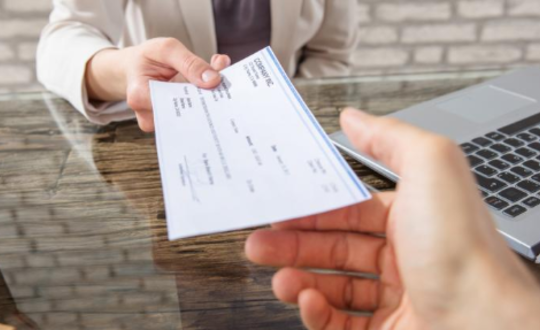Take the Cash or the Claim? Intersection of Sections 502(h), 503(b)(9) and 547 of the Bankruptcy Code
Jan 25 2024
An audio summary of this article is available in the player below. Scroll to keep reading.
Listen and subscribe to Womble Perspectives wherever you get your podcasts.
You ship goods to a customer that is having financial difficulties. The customer sends you a check for the goods. What do you do?
Cash it and potentially be sued for a preference after the customer files for bankruptcy
or
Don’t cash it, and have a claim in the ensuing bankruptcy
Cash the check because if you receive a preferential demand later,1 you will usually have to return only a portion of the money and you will keep the rest. The alternative is worse because if you don’t cash it, you will have a general unsecured claim that is likely worth only pennies in the bankruptcy.
Now, let’s change the hypothetical slightly. It’s within 20 days of a bankruptcy filing, and you ship goods to a customer.2 The customer sends you a check for the goods. What do you do?
Here, the answer is not so clear.
If you don’t cash the check, you will have a Section 503(b)(9) administrative expense claim in the bankruptcy. That claim is far more valuable than a general unsecured claim because administrative expense claims are of a higher priority and must be paid in full for a plan to be confirmed.
But what happens in this situation if you cash the check? You get the money now, and then you are possibly subject to a preference claim in the future. If you have to return the money, even just 50% of it, that means you are 50% out, which is certainly not as good as having been paid in full on the administrative expense claim. Can you defend the preference by saying:
“Well, I was not preferred, since if I wasn’t paid this money, I would have had an administrative expense claim and thus would have been paid in full. In other words, the payment did not enable me to be paid more. And if I have to return the money, I will just file a 503(b)(9) claim at that time, which has to be paid in full, so this is all just a waste of time. “
Will a court accept that defense? On January 18th, Bankruptcy Judge Lisa Beckerman of the Southern District of New York answered that question with a NO.
In The Great Atlantic & Pacific Tea Company bankruptcy, the Official Committee of Unsecured Creditors filed a preference action against McKesson Corporation (“McKesson”) seeking the avoidance and recovery of ~$67.7 million. While that action has been pending for over 6 years and has a long procedural history involving numerous motions and decisions and two bankruptcy judges, the most recent decision came out on January 18th from Judge Beckerman. In this decision, Judge Beckerman addressed the following:
The Defendant argues … that any judgment rendered on the preference claim would be futile because the resulting section 502(h) claim for any avoided preferential transfers would not be an unsecured claim, but would be an administrative claim under section 503(b)(9) [as] … section 502(h) requires that the transferee be put back in the same position as it would be had the preferential transfer never been made.
The Court denied the Defendant’s motion and held:
[I]f a preference judgment against the Defendant were rendered in this Adversary Proceeding, the Defendant paid the amount of the preference judgment in full, and then the Defendant filed a claim for the amount of the paid preference judgment, the Defendant would not have an allowed section 503(b)(9) claim, but would have an allowed unsecured claim in the amount of the paid preference judgment.
Judge Beckerman held that McKesson was seeking a 503(b)(9) post-petition claim, something that section 502(h)3 did not provide for as section 502(h) only provided for a pre-petition claim.4
The singer (not bankruptcy attorney) Steve Miller would tell you to take the money and run. Based on the holding in A&P v. McKesson, it is not clear if that is the best advice if a creditor would otherwise have a valuable 503(b)(9) claim.
1 A preference is an action under section 547 of the Bankruptcy Code where a debtor/committee/trustee can seek to force a creditor to return a payment that the creditor received in the 90 days prior to the filing of a bankruptcy.
2 Yes, this hypothetical is perhaps unrealistic since one rarely knows exactly when a company is going to file for bankruptcy.
3 Section 502(h) of the Bankruptcy Code provides “A claim arising from the recovery of property under section 522, 550, or 553 of this title shall be determined, and shall be allowed under subsection (a), (b), or (c) of this section, … the same as if such claim had arisen before the date of the filing of the petition.”
4 The Court also rejected Defendant’s citation to Fleet Nat’l Bank v. Gray (In re Bankvest Capital Corp.), 375 F.3d 51 (1st Cir. 2004) and In re Falcon Prods., Inc., 2008 WL 363045 (E.D. Mo. Feb. 8, 2008), both of which found a preference to be futile where avoidance of the transfer would result in the creditor filing a claim that would be fully paid due the claim being a priority or secured claim. In distinguishing those cases, Judge Beckerman held that they did not conflict with section 502(h) of the Bankruptcy Code because they concerned pre-petition claims, not a post-petition 503(b)(9) claim that was being asserted here.